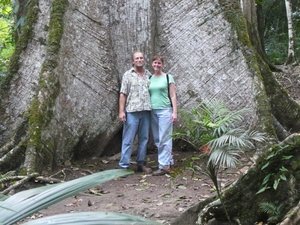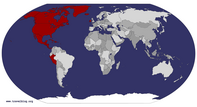Advertisement
Published: January 31st 2009

 Chuck and Leila
Chuck and Leila
Aguateca, El Peten, GuatemalaWednesday, January 21st we drove north to the Peten, which is the largest, most visited, and least populated department (similar to a state) in all of Guatemala.
Our first stop was the archaeological site of Ixcun, accessed through the town of Dolores. The town has a small museum featuring a collection of pre-Hispanic artifacts from the region. Admission was minimal. To get to Ixcun, one must drive about 18 kilometers out of town along a dirt road passing cattle farms and country homes. There are no restored structures at Ixcun; all of the remains were in complete ruin except a small collection of stelae and altars. There were no employees when we arrived, so admission to the site was free.
From Ixcun and Dolores we again drove north towards Lago Peten Itza. The main city in the area is Flores, actually used to be an island, but is now connected to the neighboring city of Santa Elena via a causeway. We expected Flores and Santa Elena to be picturesque and unique little towns. Aside from the picturesque lake view, Flores and Santa Elena were about the same as any other town in Spanish America. We stayed
a night at Hotel Express in Santa Elena. We paid $40 USD for our room which was clean and comfortable and had a nice view of the lake. Hotel Express also offers guests parking, computer and internet access, and a lakeside pool and patio. Across the street is an affordable restaurant called the Rodeo.
From Flores we drove an hour south to the river town of Sayaxche. Although this town is on the main highway from Guatemala City to Flores, there is no bridge. You must ferry over with your vehicle on a barge. When we arrived to Sayaxche there were a line of cars backed up waiting to cross. We got out of our van to find out why there was a delay. The vehicle behind ours was a cattle truck, not an enclosed truck though, it was very much open. The driver informed us that there was some sort of accident and that the barge was now submerged in the river and that we should drive to the front of the line because passenger vehicles might be able to cross before the cargo vehicles. Apparently I was standing too close to the truck while the driver
explained this to me and so I got splashed with caca de vaca (cow dung); OK!
We drove past the line of vehicles and parked along the river’s edge and next to Café del Rio, which was like a rest stop that also offered boat rides to the area archaeological sites. Earlier in the day the barge was ferrying a semi over the river, the load was too heavy, and the barge began taking on water. It seemed quite obviously we were going nowhere fast and for quite some time. I talked to the people at Café del Rio; we could park for the night, use their bathroom, and be brought by boat to the archaeological sites the next day. We spent the afternoon and part of the evening watching local efforts to remove the semi from the barge and get the barge back to working order; what an ordeal!
We decided on the archaeological site of Aguateca since it has been partially restored and is a relatively large site for the surrounding area. It took a little over an hour to get to Aguateca by boat. The captain of our boat was also the owner of the
rest stop and served as our guide at Aguateca. During pre-Hispanic times the Maya founded Aguateca, which is situated on two sides of a deep and narrow canyon. The canyon is two meters wide (at the widest point), 100 meters long, and 30 meters tall; very impressive to walk through. Residential structures are mostly on one side of the canyon, while the main plaza and government buildings were situated on the opposite side. Admission to Aguateca was nominal and we spent somewhere between two and three hours exploring the site.
After returning to Sayaxche we drove back north to Santa Elena. We had been trying to arrange for a visit to El Mirador, which is another pre-Hispanic archaeological site that is deep in the jungle. Visitors can either hike in and out (this takes 5 days) or go via helicopter (one full day). The five day hiking trip costs about $150 USD per person, for which one is provided with a guide, pack mule, food and hammock with mosquito netting. The helicopter tour is certainly much quicker however the rate is upwards of $1000 USD per person. We had sent out emails to area tour providers and thought
we would wait one more day to see if any of them would reply. By the next morning no replies were made so we made our way to Tikal.
Tikal will have a separate blog entry since it such an extensive site and we took such a large number of pictures. After our second day at Tikal we received a reply regarding a trip to El Mirador. January is considered the low season for the area, so not many people are looking to visit the more remote sites in northern Peten. We could request to be included in one of the trips during February, March or April and IF enough people made reservations THEN we could go; the rate was just under $1200 per person USD for a one day visit via helicopter. Another option was to hire our own helicopter for a cost of just over $5000 USD. We were not having much luck arranging the hiking with a mule trip either so we decided to save El Mirador for another time (well, if nothing else, we have a reason to return).
Before leaving Tikal we drove north to Uaxactun (name of both the ruin
site and town). To get to Uaxactun one must register with the administration office at Tikal, pay a reduced price admission into the park (because you actually drive through it), and drive 24 kilometers north along a dirt road that is extremely muddy and rather rough in a number of places. We only almost got stuck one time. The distance, about 15 mile, takes at least an hour and a half each way.
We parked our van at El Chiclero Restaurant and Hotel, which came highly recommended. El Chiclero also houses an impressive collection of Mayan artifacts from Uaxactun and the surrounding area. The man at El Chiclero showed us that way to the ruins; half are on one side of the town and half on the other. He said he would watch for us and after visiting the south side he would bring us another way into the northern half so that we could also see the remains of the pre-Hispanic causeway that connected the two sides. There were about half a dozen partially restored structures on the south side, one series of which were constructed to serve as an astronomical observatory that marked the equinoxes and solstices.
The northern area of the ruins consisted of a palace, plaza, what appeared to be a quadrangle, a collection of stelae, and a blowhole. After visiting the ruins of Uaxactun we returned to El Chiclero for lunch. We had chicken, rice and carrots; seriously good chicken.
After Uaxactun we drove east to Yaxha Park and Ruins. We paid about $10 USD, which included admission to the ruins and lakeside camping with showers that reminded me of the Gilligan’s Island show and bathrooms for as long as we wanted to stay (we stayed only one night). The following morning we paid about $20 USD to go by boat to the island ruins of Topoxte. At Topoxte there were only a few partially restored structures, but there was also a modern Mayan altar, some creative modern artwork and a Ramon tree with roots probably 15 feet tall. The island has been used by the Maya since about 450 BCE.
Next we visited the Yaxha ruins. Yaxha was a Late Classic site that peaked between 700 and 900 CE and was an ally to Tikal. Yaxha consists of nine acropolises and hundreds of structures some partially restored and others not
at all. Within the ruin site there are well cleared and maintained walkways with location maps and interpretive signs and stairways up some of the structures. From the top of one of the tallest structures there was a beautiful of the nearby lagoon and surrounding jungle.
By the time we finished exploring Topoxte and Yaxha it was only about 2pm. Rather than camping another night we decided to begin the 4th leg of our journey and head into Belize. Along the way we happened upon a roadside ruin site by the name of Tziquin Tzakan. There was no admission charge and we were provided with a guide to walk us through the site (again no charge). Tziquin Tzakan was a relatively small site and none of the structures have been restored; only some of the walls, one doorway and one window of one structure were only partially visible. Although there was not much to see as far as structures at Tziquin Tzakan, our guide was friendly and informative and it made for one last walk in the Peten jungle before departing Guatemala.
We spent about one week in the Peten, we could have easily spent a full
month. There are many parks and ruin sites, many of which are not easily accessible but surely worth the work of accessing them. As I said earlier, we now have a reason to return.
Advertisement
Tot: 0.065s; Tpl: 0.014s; cc: 9; qc: 27; dbt: 0.0371s; 1; m:domysql w:travelblog (10.17.0.13); sld: 1;
; mem: 1.1mb
























cksnsn
non-member comment
hi
that is cool i am from guatemala and i like it very much